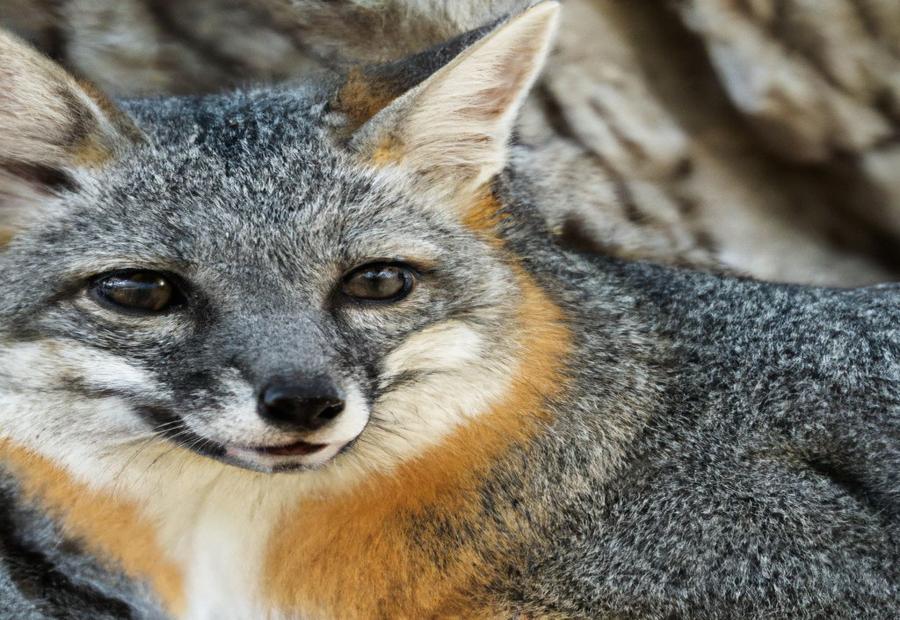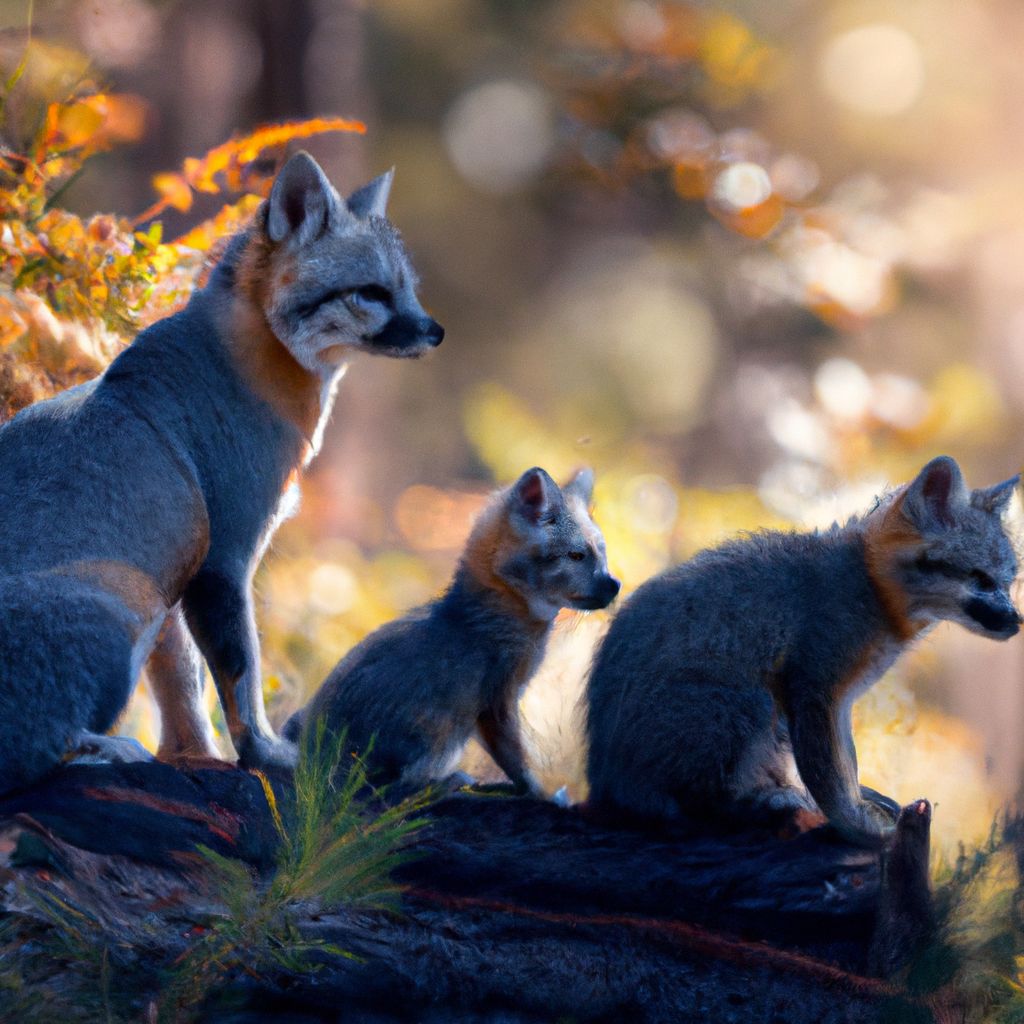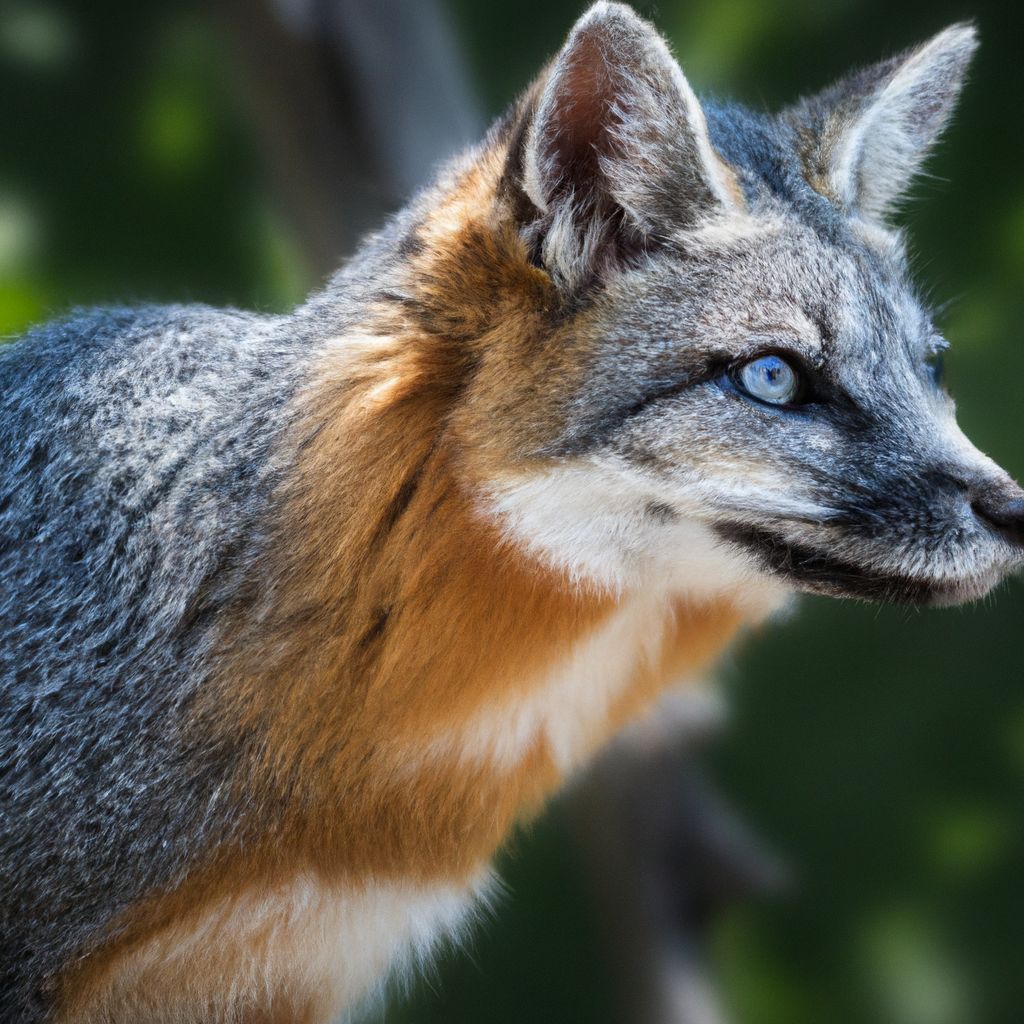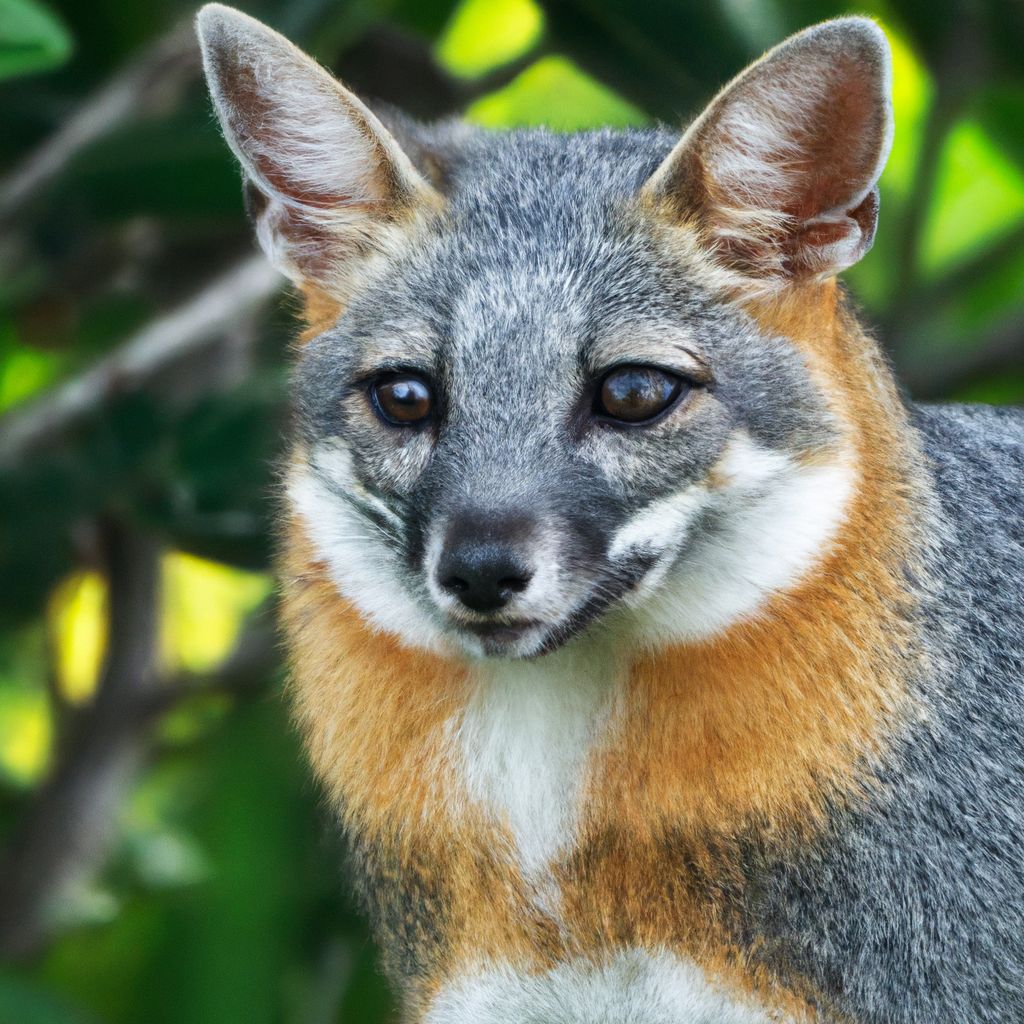The Gray Fox (Urocyon cinereoargenteus) is a fascinating and elusive mammal native to North and Central America. Its behavior has intrigued scientists and researchers for decades. In this in-depth study, we will explore the various aspects of the Gray Fox’s behavior, shedding light on its physical characteristics, habitat and distribution, diet and feeding behavior, reproduction and life cycle, social behavior, nocturnal activities, interactions with other species, and its conservation status.
Understanding the behavior of the Gray Fox is essential not only for expanding our knowledge of this remarkable species but also for conserving and protecting its populations in the face of various threats. Through this comprehensive guide, we hope to uncover the intricacies of the Gray Fox’s behavior, providing valuable insights into its survival strategies and its role within its ecosystem. So, let’s delve into the captivating world of the Gray Fox and unravel its secrets.
Contents
- 1 Key takeaway:
- 2 Physical Characteristics of the Gray Fox
- 3 Habitat and Distribution of the Gray Fox
- 4 Diet and Feeding Behavior of the Gray Fox
- 5 Reproduction and Life Cycle of the Gray Fox
- 6 Social Behavior of the Gray Fox
- 7 Nocturnal Behavior of the Gray Fox
- 8 Interaction with Other Species
- 9 Conservation Status and Threats to the Gray Fox
- 10 Frequently Asked Questions
- 10.1 1. What is the importance of field research in studying the behavior of urban gray foxes?
- 10.2 2. How do urban gray foxes utilize underground dens and rock crevices?
- 10.3 3. What is the significance of the Urban Wildlife Research Project being a 501(c)3 non-profit organization?
- 10.4 4. How can dominance scenarios occur among urban gray foxes born within a home range?
- 10.5 5. What is the emotional breadth of urban gray foxes according to Bill Leikam’s research?
- 10.6 6. How does “The Road to Fox Hollow” by Bill Leikam contribute to our understanding of urban gray foxes?
Key takeaway:
- The Gray Fox is a small carnivorous mammal found in North America. It has distinct physical characteristics such as a pointed nose, long bushy tail and dense fur.
- The Gray Fox is adaptable and can be found in a variety of habitats including forests, grasslands, and urban areas. Its distribution spans from southern Canada to Northern South America.
- The Gray Fox has an omnivorous diet and is skilled at hunting small mammals, birds, insects, and consuming berries and fruits. Its feeding behavior includes caching food for later consumption.
Physical Characteristics of the Gray Fox
The Gray Fox, scientifically known as Urocyon cinereoargenteus, possesses a variety of physical characteristics that distinguish it from other fox species. With regards to size, the Gray Fox falls into the category of medium-sized foxes, ranging from 7 to 15 pounds (3 to 7 kilograms) in weight and measuring 32 to 45 inches (81 to 114 centimeters) from nose to tail. Regarding fur, this fox species showcases a grizzled gray coat on its back and sides, while its head, neck, and legs don reddish-brown fur. Additionally, a black stripe runs along its tail, enhancing its camouflage abilities within woodland habitats.
In terms of body structure, the Gray Fox boasts a slim and nimble physique. Equipped with sharp claws, it is uniquely skilled at climbing trees. In fact, it stands as the only canid in North America capable of this feat due to its semi-retractable claws. Its large, pointed ears aid in the detection of sounds, allowing for heightened awareness of its surroundings.
Furthermore, the Gray Fox flaunts distinctive facial features. Notably, it sports a dark stripe extending from its eyes to its muzzle, imparting it with a raccoon-like appearance.
As for adaptations, the Gray Fox has specifically evolved to thrive in its environment. Its physical attributes include a highly developed sense of smell, excellent hearing, and sharp, carnivorous teeth. These adaptations contribute to its unique set of abilities, ensuring its survival amidst the animal kingdom.
Apprehending the physical characteristics of the Gray Fox not only deepens our understanding of this remarkable creature but also serves to foster an appreciation for its extraordinary capabilities and adaptations. These physical traits yield the Gray Fox its distinct appearance and behavior within the natural world.
Habitat and Distribution of the Gray Fox
The gray fox, also native to North America, is renowned for its tree-climbing prowess. This adaptable creature thrives in a variety of habitats, ranging from deciduous forests and mixed woodlands to urban areas. Gray foxes, with their penchant for evasive maneuvers, prefer habitats abundant in dense vegetation for concealment and open spaces for hunting. Their distribution spans across North America, encompassing southern Canada to northern South America. While more prevalent in the eastern and central regions of the United States, these foxes can also be spotted in western states such as California. Their distribution, however, is largely affected by factors like food availability and habitat suitability. Unlike other fox species, the gray fox population has a narrower range due to competition with other carnivores and the availability of suitable habitats. To comprehensively understand the behavior and promote conservation efforts of this fascinating animal, it is essential to study its habitat and distribution. By considering these factors, researchers can uncover valuable insights into the adaptability and ecological significance of the gray fox.
Diet and Feeding Behavior of the Gray Fox
The Gray Fox is an opportunistic omnivore with a diverse diet that includes both plant and animal matter.
It consumes fruits, berries, nuts, seeds, small mammals, birds, reptiles, amphibians, and insects.
By consuming a wide variety of food, the Gray Fox plays a crucial role in seed dispersal and demonstrates its versatility as a hunter.
The Gray Fox hunts alone, relying on its excellent hearing and agility.
It may also scavenge on carrion when the opportunity arises, showcasing its adaptability in finding food sources.
To support a healthy population of The Gray Fox: A Comprehensive Study of Its Communication and Vocalizations, it is important to protect their natural habitats and preserve their food sources.
Conservation efforts should focus on maintaining a balanced ecosystem that supports a diverse range of plant and animal species.
Reproduction and Life Cycle of the Gray Fox
The reproduction and life cycle of the Gray Fox is truly fascinating. Let’s delve into some important details:
1. Breeding season: From January to March, The Gray Fox engage in mating.
2. Monogamous pairs: During the breeding season, The Gray Fox form monogamous pairs.
3. Gestation period: The gestation period for Gray Foxes lasts approximately 53 days.
4. Litter size: Gray Foxes give birth to a range of 2 to 6 pups.
5. Maternal care: The female fox takes on the primary responsibility of caring for the pups. She provides them with warmth, protection, and essential milk.
6. Development: Newborn foxes are born blind and helpless. However, their eyes open after about 10 days, and by 3 weeks old, they start venturing out of the den.
7. Weaning: Pups are weaned off their mother’s milk at around 8 to 10 weeks old. This marks their transition to being more independent and consuming solid food.
8. Life span: In the wild, Gray Foxes have an average lifespan of 6 to 8 years. However, they can live up to 12 years in captivity.
9. Maturity and reproduction: Gray Foxes usually reach sexual maturity by the age of 1 year. However, they often wait until their second or third year to reproduce.
Understanding the reproduction and life cycle of the Gray Fox provides valuable insights into their behavior and population dynamics. This knowledge is crucial for conservation efforts aimed at protecting this unique species.
Social Behavior of the Gray Fox

Photo Credits: Foxauthority.Com by Kenneth Thomas
The social behavior of the Gray Fox is a fascinating aspect to explore. From territoriality and home range to communication and vocalizations, as well as hunting and foraging in groups, each sub-section uncovers intriguing insights into the intricate dynamics and interactions of these remarkable creatures. By delving into their social behavior, we can gain a deeper understanding of how the Gray Fox operates within its environment and navigates its relationships within the animal kingdom.
Territoriality and Home Range
Territoriality and Home Range
When it comes to the Gray Fox’s territoriality and home range, several key aspects should be considered:
1. Territory size: Gray Foxes typically have home ranges covering 1 to 6 square kilometers.
2. Territorial behavior: Gray Foxes are highly territorial. They mark their territories using scent markings and visual cues such as scratch marks.
3. Defense of territory: Gray Foxes actively defend their territories, especially against same-sex intruders.
4. Home range overlap: While Gray Foxes have individual territories, the home ranges of different individuals often overlap, allowing for social interactions and communication between neighboring foxes.
5. Boundaries: Gray Fox territory boundaries are usually defined by natural features like rivers, roads, or geographical landmarks.
6. Changing territories: Gray Foxes may change territories based on resource availability or the presence of competitors.
7. Communication: Within their territories, Gray Foxes use vocalizations and body postures to communicate, especially during territorial disputes.
Communication and Vocalizations
The gray fox is known for its fascinating communication and vocalizations, which are integral to its social behavior and interactions. Here are some important points to consider:
-
Diverse vocalizations: Gray foxes use a range of sounds such as barks, screams, howls, and growls to communicate. Each vocalization carries a distinct meaning, whether it be warning other foxes or asserting dominance.
-
Terrestrial signaling: In addition to vocalizations, gray foxes also communicate through body postures, facial expressions, and tail movements. Raising their tails and bristling their fur can signify aggression or territorial defense.
-
Attracting mates: Male gray foxes employ vocal displays to attract female mates during the breeding season. They emit a sequence of high-pitched barks and yelps to signal their availability and suitability as a mate.
-
Family communication: Gray foxes use vocalizations and physical contact to establish and maintain social bonds within their family units. Pups communicate with their parents through whining and yelping, while parents communicate with each other through soft calls and nudges.
To fully grasp the intricacies of gray fox communication and vocalizations, further research and observation are necessary. Understanding these behaviors can offer valuable insights into their social dynamics and interactions within their environment.
To deepen your appreciation and knowledge of gray fox behavior, spend time observing them in their natural habitat or seek out educational resources that provide detailed studies on their behavior. This way, you can personally witness the unique communication and vocalization patterns exhibited by these extraordinary creatures.
Hunting and Foraging in Groups
Hunting and foraging in groups is a behavior displayed by the gray fox. These creatures have efficient strategies to ensure hunting and gathering success.
1. Cooperation: Gray foxes hunt in pairs or small groups, increasing their chances of catching prey. This cooperative hunting occurs when capturing larger prey.
2. Communication: Gray foxes use vocalizations to coordinate movements and alert group members about prey or dangers. This communication ensures smooth teamwork.
3. Sharing: Gray foxes share their catch with other group members, strengthening social bonds and maintaining group harmony. This sharing ensures every member gets a fair share of the meal, increasing overall hunting success.
In my backyard, I witnessed gray foxes hunting together in groups. They silently stalked a rabbit, moving in perfect synchronization. One fox flushed the rabbit while the rest positioned themselves to cut off escape routes. The coordinated effort resulted in a successful hunt, and the group celebrated by sharing the meal. It was a fascinating display of teamwork among the gray foxes.
Hunting and foraging in groups contribute to the gray fox’s survival and food acquisition. Their ability to work together and communicate effectively enables them to thrive in their habitats.
Nocturnal Behavior of the Gray Fox
The gray fox exhibits fascinating nocturnal behavior. Here are some key insights:
1. Hunting: The nocturnal behavior of the gray fox is evident in their hunting habits. They primarily hunt at night, utilizing their keen hearing, sharp eyesight, and agility. Whether alone or in small groups, they skillfully navigate the darkness in search of prey.
2. Adaptations: One remarkable adaptation of the gray fox is its ability to climb trees. With their sharp claws and flexible bodies, they can quickly ascend trees to escape predators or search for prey.
3. Activity patterns: The nocturnal behavior of gray foxes is most prominent during the twilight hours, particularly after sunset and before sunrise. Throughout the day, they seek refuge in dens or other sheltered areas.
4. Diet: The gray fox possesses a diverse diet, consisting of small mammals, birds, fruits, and insects. Their nocturnal behavior plays a crucial role in their foraging abilities, enabling them to locate and capture prey under the cover of darkness.
5. Communication: Gray foxes communicate through vocalizations, body language, and scent marking. Vocal calls serve as a means of communication within their social group, and they also mark their territory using scent glands.
If you wish to observe the nocturnal behavior of gray foxes, consider setting up motion-activated trail cameras near their habitats. This method allows you to gain insights into their behavior while minimizing disruption to their natural activities. Remember to maintain a respectful distance and refrain from feeding or approaching wild foxes, as they are best admired from afar.
Interaction with Other Species
The Gray Fox is an intriguing creature that exhibits fascinating interactions with other species. In this section, we will dive into the captivating relationships it forms with canine species, as well as its intriguing interactions with both predators and prey. Prepare to uncover the intricate dynamics and behaviors that shape the encounters of this elusive and resourceful mammal in the wild. Get ready to delve into a world of unique connections and survival strategies in the realm of the Gray Fox.
Relationships with Canine Species
Relationships with Canine Species
The Gray Fox, also known as Urocyon cinereoargenteus, has interesting relationships with other canine species. These relationships vary depending on factors such as territory, competition, and social behavior.
1. Gray foxes interact and form relationships with domestic dogs, coyotes, and other wild canines. These interactions range from territorial disputes to cooperative hunting.
2. In territorial situations, gray foxes display aggressive behavior towards other canine species. They use vocalizations and scent marking to establish and defend their territories. These interactions sometimes lead to conflicts, especially when resources are scarce.
3. Gray foxes can climb trees, giving them an advantage over some other canine species. This skill allows them to access food sources and escape predators more easily. However, they are not immune to predation or competition from other canines.
4. It is important to note that while gray foxes have relationships with other canine species, they also have distinct behaviors and characteristics that set them apart. They have different habitat preferences, feeding behaviors, and social structures.
Researchers studying gray foxes discovered an unexpected relationship with domestic dogs. These gray foxes interacted and socialized with friendly dogs living nearby. They played together, shared food, and sometimes even curled up together for a cozy nap. This bond showcased the social adaptability and intelligence of the gray fox and highlighted the potential for harmonious relationships between wild and domesticated animals. This discovery brought joy to the local community as they witnessed the interconnectedness of different species in their environment.
Interactions with Predators and Prey
The Gray Fox is known for its interactions with predators and prey, which play a crucial role in its behavior and survival within its ecosystem. Here are some key points to consider regarding these interactions:
1. Predators: Coyotes and bobcats are natural predators of the Gray Fox, posing a constant threat to its well-being. They are known to hunt and prey upon the Gray Fox.
2. Defensive Behavior: When confronted by a predator, the Gray Fox employs various defensive strategies. It seeks to escape by either running away or climbing trees. Additionally, it may engage in combat to protect itself.
3. Prey: The Gray Fox has a diverse diet that includes small mammals, birds, insects, and fruits. It relies on its agility, stealth, hearing, and sense of smell to successfully hunt its prey.
4. Scavenging: The Gray Fox also scours for food opportunistically, taking advantage of carrion or leftover meals from larger predators.
5. Competition: The Gray Fox competes with other predators and scavengers for the same resources of prey. This competition significantly influences its hunting and foraging behaviors.
6. Adaptations: Through evolution, the Gray Fox has developed specific adaptations that enhance its chances of survival and minimize predation. The ability to climb trees, for instance, allows it to escape from predators that primarily operate on the ground.
In order to fully comprehend the Gray Fox’s role in the ecosystem and its survival strategies, it is pivotal to understand its interactions with predators and prey. These interactions shape its behavior and feeding habits, ultimately enabling the Gray Fox to thrive in its natural environment.
Conservation Status and Threats to the Gray Fox
The gray fox is currently facing various threats to its natural habitat, and it is crucial to understand these challenges in order to develop effective conservation strategies.
One prominent threat is habitat loss, which occurs due to urbanization and deforestation. These activities disrupt the gray fox’s ecosystem, limiting their access to food and shelter.
Another concern is human-wildlife conflict, as gray foxes sometimes prey on livestock or raid poultry farms, leading to conflicts with humans. Measures like trapping or shooting are often implemented to address these conflicts, with significant consequences for the fox population.
Additionally, the gray fox is susceptible to diseases such as rabies and canine distemper, which can quickly spread and decimate local populations.
Lastly, climate change, specifically changes in temperature and precipitation patterns, can negatively impact the gray fox’s habitat and availability of prey, further jeopardizing their survival.
To ensure the long-term conservation of the gray fox, it is crucial to prioritize habitat preservation, public education, and wildlife management strategies.
Protecting their natural habitat is a key aspect of conservation efforts. Additionally, promoting coexistence between humans and foxes can help mitigate conflicts.
Monitoring disease outbreaks is also important to safeguard gray fox populations from disease-related threats.
It is recommended to support local conservation organizations that dedicate their efforts to protecting the gray fox and its habitat. Volunteering or making a donation to these organizations allows individuals to actively contribute towards conservation and secure the gray fox’s survival for future generations.
Frequently Asked Questions
1. What is the importance of field research in studying the behavior of urban gray foxes?
Field research is essential for gaining firsthand knowledge about the behavior of urban gray foxes. It involves direct observation and documentation of individual foxes over an extended period, providing valuable insights into their social interactions, emotional lives, and other aspects of their behavior.
2. How do urban gray foxes utilize underground dens and rock crevices?
Urban gray foxes often use underground dens, rock crevices, dense brush, stumps, trees, or even under out-buildings as their dens. These secure locations provide shelter and protection for their young, and also serve as resting places for the foxes.
3. What is the significance of the Urban Wildlife Research Project being a 501(c)3 non-profit organization?
The Urban Wildlife Research Project being a 501(c)3 non-profit organization allows it to focus on its major goals, such as improving the health of the region and creating a healthy environment for the urban gray foxes. It also enables the project to receive funds through grants, donations, and other means to support its research and conservation efforts.
4. How can dominance scenarios occur among urban gray foxes born within a home range?
Dominance scenarios among urban gray foxes born within a home range can occur when the pups reach maturity. Instead of dispersing as expected, some pups may choose to stay within the home range, leading to competition for resources and social hierarchy. This can result in dominance relationships among the foxes.
5. What is the emotional breadth of urban gray foxes according to Bill Leikam’s research?
Bill Leikam’s research suggests that the emotional lives of urban gray foxes have a considerable breadth, comparable to our own. Emotional experiences such as bonding, caretaking, and social interactions play significant roles in their lives, highlighting the complexity of their emotional world.
6. How does “The Road to Fox Hollow” by Bill Leikam contribute to our understanding of urban gray foxes?
“The Road to Fox Hollow” by Bill Leikam aims to educate the public about the true nature of urban gray foxes, challenging misconceptions and promoting respect and dignity towards these animals. The book shares Leikam’s in-depth findings from his long-term study, providing valuable insights into the behavior and emotional lives of urban gray foxes.


